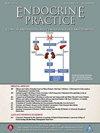Imaging of Adrenal Masses
IF 4.6
3区 医学
Q2 ENDOCRINOLOGY & METABOLISM
引用次数: 0
Abstract
Objective
Adrenal lesions are common and require appropriate management when clinically relevant. The approach to the evaluation of an adrenal lesion is to exclude malignancy and hormone excess as these are associated with significant morbidity and mortality.
Methods
Imaging of adrenal lesions primarily aims to identify features indicating benignity. Noncontrast computed tomography is recommended as first-line imaging for adrenal lesions. Indeterminate lesions that require further characterization may proceed to adrenal protocol computed tomography (with contrast) or magnetic resonance imaging, with a trend in recent years towards increasing use of magnetic resonance imaging. Positron emission tomography-computed tomography may also be used to assess adrenal lesions in certain clinical scenarios.
Results
Clinical guidelines recommend that all adrenal incidentalomas require further dedicated imaging unless they are clearly benign on imaging. The imaging strategy of adrenal lesions depends upon a number of factors including patient history, nature of detection, imaging characteristics (size, heterogeneity, presence of intracellular lipid), and the presence or absence of hormone excess. Special considerations are given to pregnant patients, young patients <40 years, and those with a history of an extra-adrenal malignancy.
Conclusion
This review outlines the role of imaging for adrenal lesions, describes the various imaging options and investigation strategies, and highlights relevant imaging findings.
肾上腺肿块的影像学。
肾上腺病变是常见的,需要适当的管理时,临床相关。评估肾上腺病变的方法是排除恶性肿瘤和激素过量,因为这些与显著的发病率和死亡率有关。肾上腺病变的影像学检查主要目的是识别显示良性的特征。非对比CT推荐作为肾上腺病变的一线影像学检查。需要进一步表征的不确定病变可进行肾上腺CT(对比)或MRI检查,近年来MRI的使用越来越多。在某些临床情况下,PET-CT也可用于评估肾上腺病变。临床指南建议所有肾上腺偶发瘤需要进一步的专门成像,除非它们在成像上明显是良性的。肾上腺病变的影像学策略取决于许多因素,包括患者病史、检测性质、影像学特征(大小、异质性、细胞内脂质的存在)以及激素过量的存在或不存在。特别考虑到孕妇,年轻患者< 40岁,和那些有肾上腺外恶性肿瘤的历史。这篇综述概述了肾上腺病变影像学的作用,描述了各种影像学选择和调查策略,并强调了相关的影像学发现。
本文章由计算机程序翻译,如有差异,请以英文原文为准。
求助全文
约1分钟内获得全文
求助全文
来源期刊

Endocrine Practice
ENDOCRINOLOGY & METABOLISM-
CiteScore
7.60
自引率
2.40%
发文量
546
审稿时长
41 days
期刊介绍:
Endocrine Practice (ISSN: 1530-891X), a peer-reviewed journal published twelve times a year, is the official journal of the American Association of Clinical Endocrinologists (AACE). The primary mission of Endocrine Practice is to enhance the health care of patients with endocrine diseases through continuing education of practicing endocrinologists.
 求助内容:
求助内容: 应助结果提醒方式:
应助结果提醒方式:


